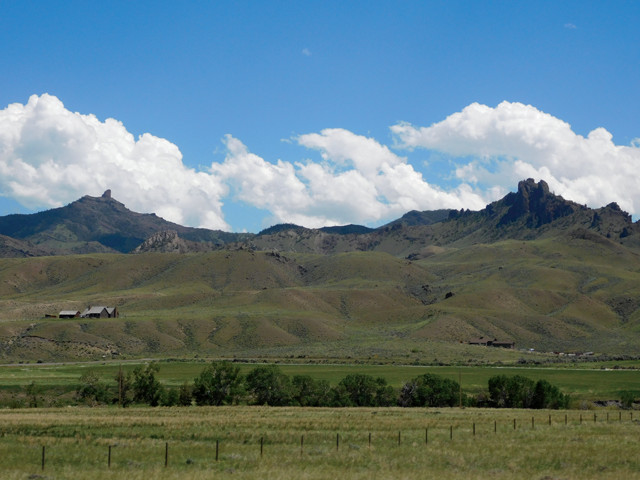
by Adityarup "Rup" Chakravorty Tuesday, August 15, 2017

Credit: Sara E. Pratt.
Oxidants in the troposphere, such as ozone and hydroxyl radicals, influence the life spans of other atmospheric components, including pollutants and greenhouse gases like carbon monoxide and methane. But how the abundance of tropospheric oxidants varies as climate changes is poorly understood. Part of the challenge is that these oxidants are too reactive to be preserved in paleo-records, such as ice cores.
In a recent study in Nature, however, researchers examined Greenland ice cores and used a proxy for ozone and hydroxyl abundances to reconstruct the relative levels of these oxidants in the troposphere over the last 100,000 years. Counter to current thinking, the study indicates that levels of ozone were higher relative to hydroxyl levels when the climate was colder.
“It’s important we understand the dynamics of tropospheric oxidants as temperatures fluctuate if we are to calculate accurately how they affect climate change,” says Becky Alexander, an atmospheric scientist at the University of Washington and an author of the new study. For instance, oxidants influence the residence time of methane in the atmosphere. “When we measure atmospheric levels of methane from ice-core samples, it’s typically assumed that the oxidant levels haven’t changed over time, but we show that levels of oxidants can vary with time and temperature,” Alexander says.
To gauge levels of ozone and hydroxyl in the paleo-troposphere, Alexander and her colleagues examined oxygen isotopes in nitrates preserved in the ice cores. “Nitrate in the atmosphere is formed entirely through reactions of its precursors with oxidants,” Alexander says. The proportions of oxygen-17 and oxygen-18 in the nitrates depend on the oxidant — ozone or hydroxyl — with which the nitrate precursors reacted.
“The expectation was that, in cold climates, the ozone concentration in the troposphere would decrease because emissions of its precursors from biological sources on the surface would be lower in colder temperatures,” Alexander says. Hydroxyl concentrations, on the other hand, were expected to stay relatively constant. But based on the relative amounts of oxygen-17 and oxygen-18 in the ice-core nitrates, the researchers calculated that in the past when temperatures were lower there was more ozone, relative to hydroxyl radicals.
The “strong correlation between the proxy the authors used as a surrogate for tropospheric oxidation capacity with temperature … indicates that chemistry-climate interactions are closely linked,” says Michaela Hegglin, an atmospheric scientist at the University of Reading in England, who wasn’t involved with the study. That correlation also indicates “that such proxy data offer great opportunities to investigate feedbacks in the climate system,” she says.
However, Hegglin adds, the new study looks at the relative abundance of ozone and hydroxyl, and not their absolute amounts. “It could be that ozone and hydroxyl levels both decreased with temperature, with hydroxyl radical levels falling at a slightly higher rate,” she says. That would also yield a higher ozone-to-hydroxyl ratio.
Alexander and her colleagues offer two explanations for their surprising findings. The first involves an increase in a phenomenon called the Brewer-Dobson circulation, in which air from the troposphere ascends into the stratosphere near the tropics, travels poleward and then descends back into the troposphere in the mid- and high latitudes.
“The Brewer-Dobson circulation is a way for ozone from the stratosphere to enter the troposphere,” Alexander says. Today, it’s a relatively minor source of ozone in the troposphere, but increased sea-surface temperature gradients between the tropics and the polar regions, such as during past glacial periods, could have strengthened specific portions of the circulation patterns, leading to an increase in the amounts of tropospheric ozone.
Another possibility involves interactions between the oxidants and reactive halogens, such as bromine, in the atmosphere. “We are only beginning to understand the importance of reactive halogens, and there is still a lot of uncertainty about how they influence the levels of oxidants,” Alexander says.
Hegglin says these are plausible explanations. “However, I would argue we need more research to test these hypotheses using more complex modeling approaches that can simulate all the processes in one system,” she says. “If we do not gain a better understanding of chemistry-climate feedback mechanisms, and if our models lack the capability to simulate them, then climate change may hold some surprises — positive or negative — for us.”
© 2008-2021. All rights reserved. Any copying, redistribution or retransmission of any of the contents of this service without the expressed written permission of the American Geosciences Institute is expressly prohibited. Click here for all copyright requests.